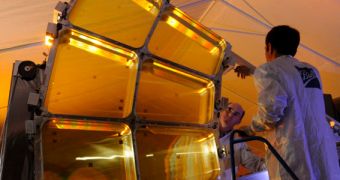For the first time ever, researchers with the US Defense Advanced Research Projects Agency (DARPA) and Ball Aerospace were recently able to demonstrate that it is possible to capture images using lightweight membrane optics. This could lead to a complete revolution in space telescope design.
This achievement was made possible through the DARPA Membrane Optical Imager for Real-Time Exploitation (MOIRE) program, which seeks to move away from conventional telescope designs that unavoidably use lenses, mirrors and glass as the main “eyes” of the instrument.
At this point, glass cannot be fashioned at the scale needed for ever-more-detailed observations. The material is also too cumbersome to use, too heavy, and too expensive when it has to be manufactured at extreme levels of precision.
The new MOIRE design uses new lightweight polymer membrane optics to replace glass mirrors, and could be the first step towards creating more advanced telescopes that can unfold in space. Though less effective than glass, the membrane allows for the creation of significantly larger lenses, which makes up for their original drawback.

 14 DAY TRIAL //
14 DAY TRIAL //